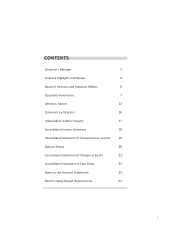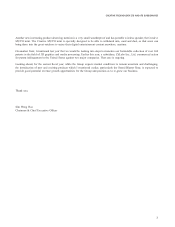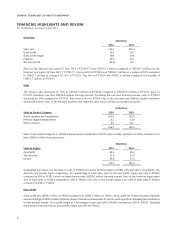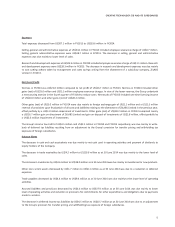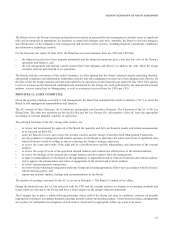Creative 2014 Annual Report Download - page 7
Download and view the complete annual report
Please find page 7 of the 2014 Creative annual report below. You can navigate through the pages in the report by either clicking on the pages listed below, or by using the keyword search tool below to find specific information within the annual report.
7
CREATIVE TECHNOLOGY LTD AND ITS SUBSIDIARIES
CORPORATE GOVERNANCE
For the nancial year ended 30 June 2014
Creative Technology Ltd (“Creative” or the “Company”, and together with its subsidiaries, the “Group”) is committed to maintaining
good corporate governance in accordance with the principles and guidelines set out in the Code of Corporate Governance issued
in May 2012 (the “Code”). Creative’s approach on corporate governance takes into consideration the principles and guidelines
set out in the Code, substantially complied with the key principles and supporting guidelines set out in the Code except where
specically identied and disclosed in this report.
This report outlines the main corporate governance practices that were in place throughout the nancial year, with specic references
to each of the principles of the Code.
PRINCIPLE 1: THE BOARD’S CONDUCT OF ITS AFFAIRS
The principal functions of the Board of Directors of the Company (the “Board”) are to provide guidance and to decide on certain
important matters, including those involving the review and approval of strategic plans, direction and policies, to review the Group’s
performance, to review the adequacy and integrity of internal controls, and to approve material acquisitions and disposals of assets.
These functions are either carried out directly by the Board or through committees, namely the Audit Committee, the Nominating
Committee and the Remuneration Committee, established by the Board (collectively referred to as “Board Committees”).
Matters which are specically reserved to the full Board for decision-making include those involving the review and approval of
strategic plans, direction and policies, material acquisitions and disposals of assets, corporate or nancial restructuring and share
issuances, dividends and other returns to shareholders.
The Articles of Association of the Company allow the Company’s Directors to participate in a Board meeting by telephone
conference or video conference whereby all persons participating in the meeting are able to communicate as a group, without
requiring the Directors’ physical presence at the meeting.
The number of Board and Board Committee meetings held in the nancial year ended 30 June 2014 and the attendance of directors
during these meetings is as follows:
(Number of Meengs Held) (5) (6) (2) (1)
Sim Wong Hoo 5 – 2 1
Lee Kheng Nam 5 6 2 1
Ng Kai Wa 5 6 2 1
Lee Gwong-Yih 5 6 – –
Upon appointment of each new director, a letter is provided setting out the director’s duties and obligations. The Group also conducts
an orientation programme for new directors to familiarize them with the business activities and corporate governance practices.
Directors are updated regularly on the Group’s strategic directions, nancial performance, updates on corporate governance
practices, relevant new laws, regulations and changing business risks during Board meetings or at specially-convened sessions.
Directors are also encouraged to request for sponsorship from the Company to attend courses to update their knowledge and better
equip themselves to discharge their duties as Directors.
PRINCIPLE 2: BOARD COMPOSITION AND BALANCE
The Board comprises four members, one of whom is an Executive Director and three of whom are independent non-Executive
Directors. The criteria of independence are based on the denition given in the Code. Key information regarding the Directors is
disclosed in Board of Directors and Executive Ofcers. Together the Board has a diverse wealth of experience as well as skills
and knowledge and the diversity of experience, skills and competencies of the Directors enhance the effectiveness of the Board
in carrying out its responsibilities
The Executive Director is Mr Sim Wong Hoo, the Chairman and Chief Executive Ofcer of the Company. He is also a substantial
shareholder.

